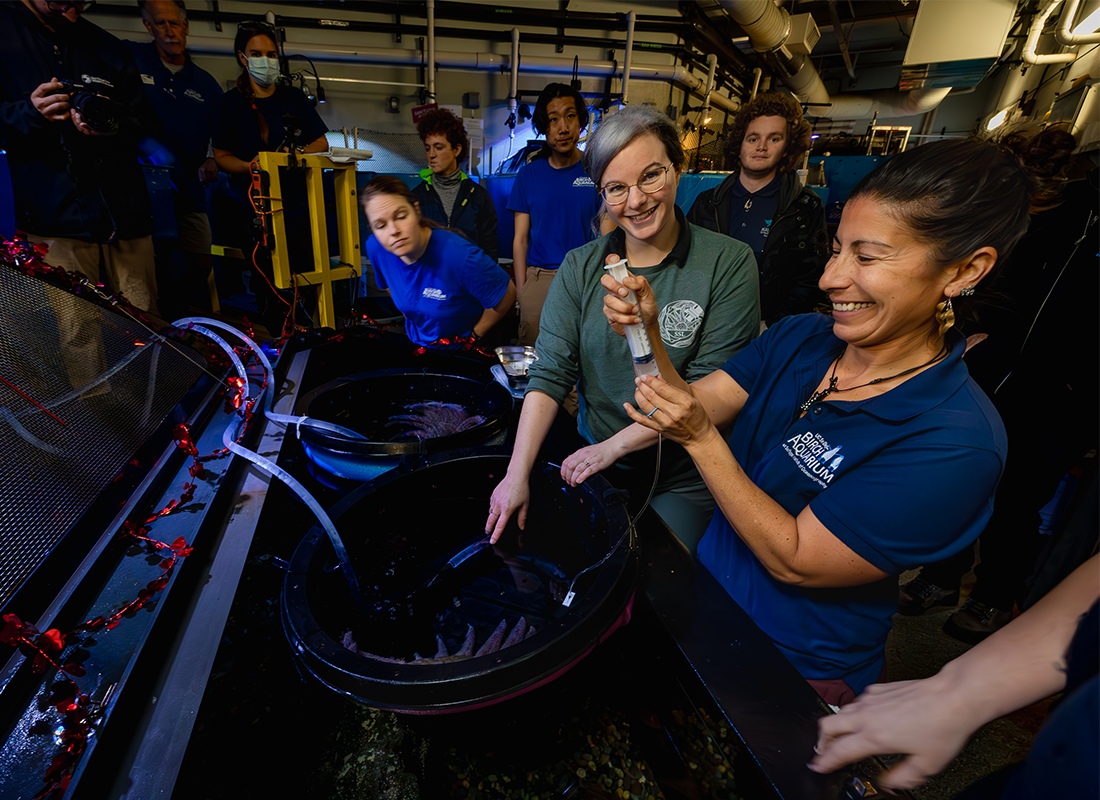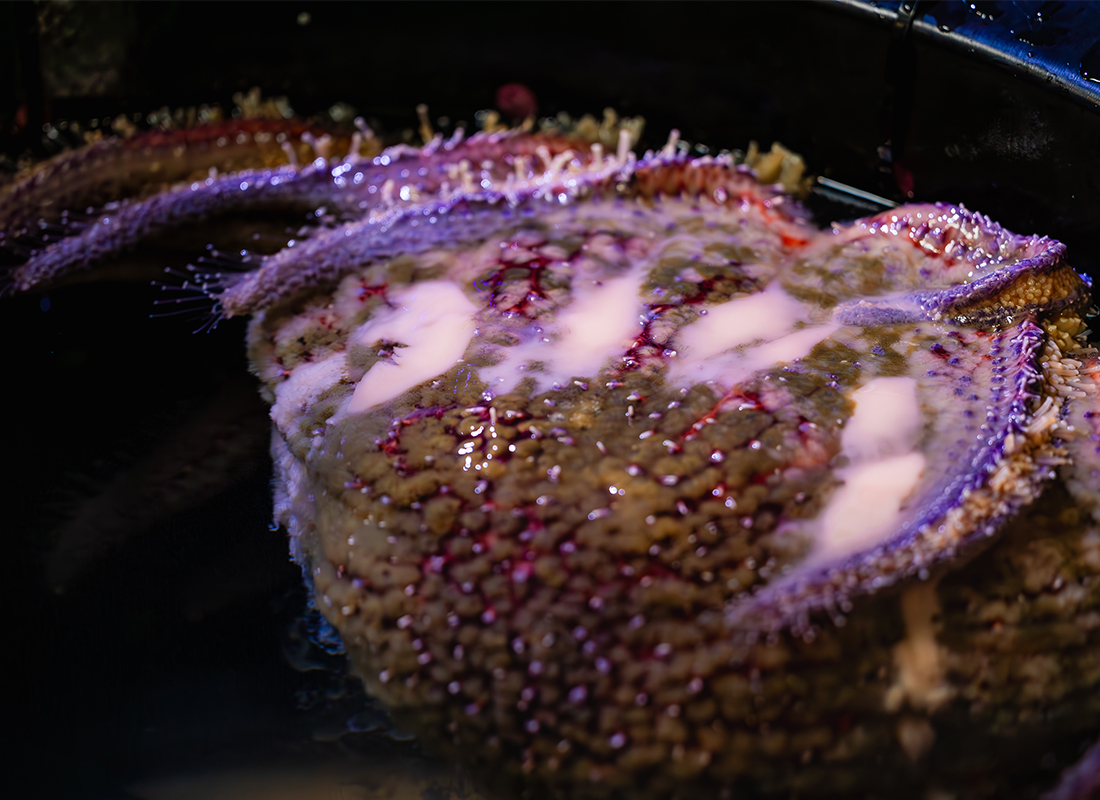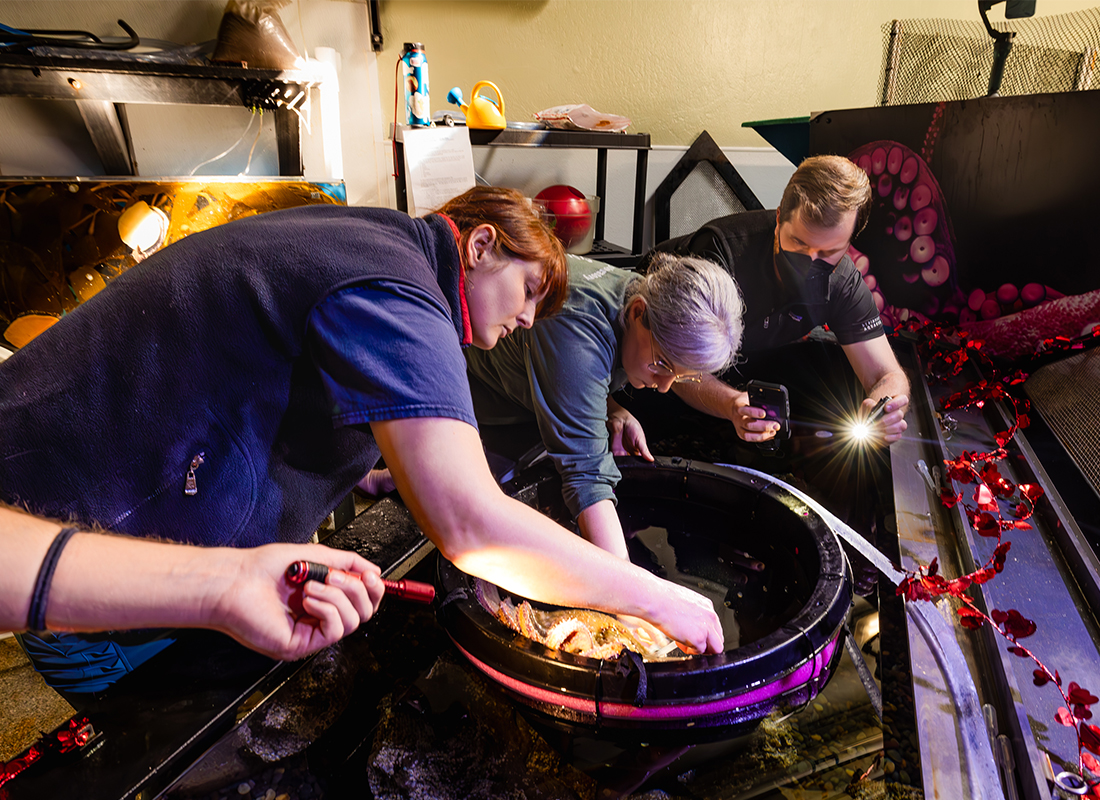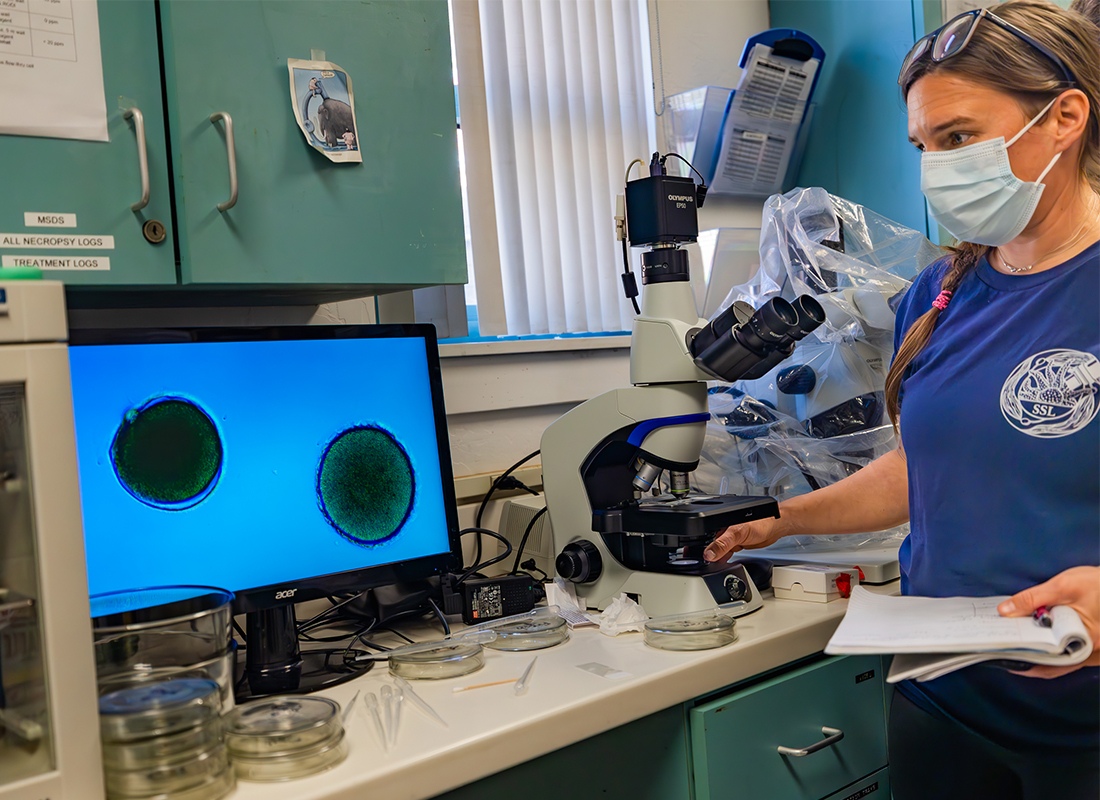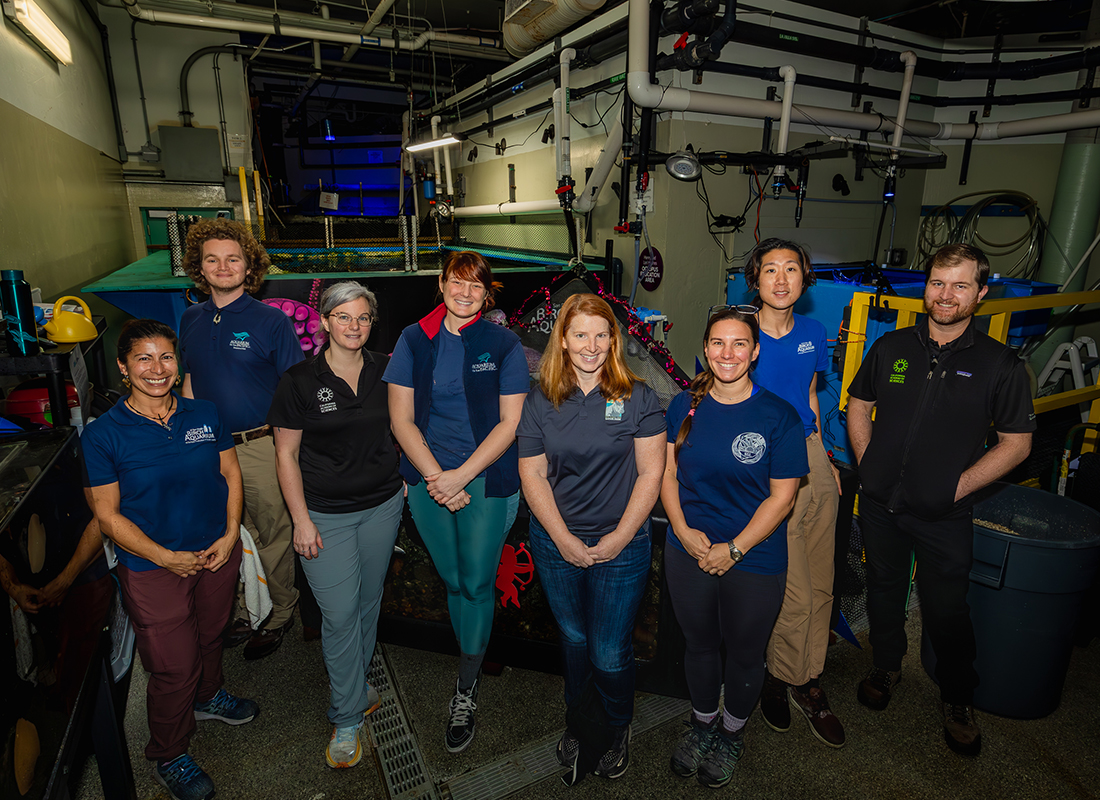Love is in the water for the critically endangered Sunflower Sea Star as a team in California successfully spawned and cross-fertilized gametes from a male and a female, resulting in fertile eggs. This success marks another incredible step forward in an ongoing collaborative effort to save the species from extinction.
This advancement took place at Birch Aquarium at Scripps Institution of Oceanography at UC San Diego, where their experts were joined by partners from the Aquarium of the Pacific, California Academy of Sciences, San Diego Zoo Wildlife Alliance (SDZWA) and Sunflower Star Laboratory.
“The collaboration and support that contributed to achieving this milestone has been huge! Birch Aquarium takes great pride in being part of this extraordinary team working towards saving Sunflower Stars," said Melissa Torres, Assistant Dive Safety Officer and Aquarist at Birch Aquarium. "We’re excited to share the diverse genetics of our Sunflower Stars with zoos, aquariums and other partners who may lack sufficient population or access to diverse genetics."
The team used three different sperm samples from the same male to fertilize the eggs. Through this approach, the team can identify optimal sperm storage techniques to enhance the chances of successful egg fertilization in future attempts.
- Fresh sperm from a male Sunflower Star at Birch Aquarium
- -80 sperm — frozen sperm stored in minus 80 C freezer
- Cryopreserved sperm stored in the SDZWA’s Frozen Zoo
Each sample yielded fertilized eggs, marking a monumental advancement in the collective endeavor to bolster the population and genetic diversity of Sunflower Stars in accredited zoos and aquariums.
Some fertilized eggs remained at Birch Aquarium, while the rest were transported to the Aquarium of the Pacific, California Academy of Sciences and additional partners throughout California. Each partner will leverage their expertise towards the goal of culturing these fertilized eggs to larvae and then adulthood.
This collaboration is part of the Association of Zoos and Aquariums (AZA) SAFE Sunflower Sea Star Program, co-led by the Aquarium of the Pacific and Omaha’s Henry Doorly Zoo & Aquarium. It also contributes to a comprehensive multi-faceted, multi-partner “Roadmap to Recovery” — led by The Nature Conservancy — to help accelerate the recovery of this species along the West Coast.
Sunflower Stars have been hit hard by sea star wasting disease that’s swept across the West Coast for the past decade. It's estimated that more than five billion Sunflower Stars have died from this disease. Efforts like this are one of many to come, and this special star has a massive group working to save them and the ecosystems that depend on them.
***
Media Contacts:
- Birch Aquarium at Scripps | Alex Feltes, afeltes@ucsd.edu \ Joanna Volavka, jcvolavka@ucsd.edu
- Aquarium of the Pacific (Long Beach, CA) | Marilyn Padilla, mpadilla@lbaop.org, 562-951-1684 \ Andreas Miguel, amiguel@lbaop.org, 562-951-1678
- San Diego Zoo Wildlife Alliance | Andrew James, ajames@sdzwa.org
- Steinhart Aquarium at California Academy of Sciences | Megan Ely, mely@calacademy.org
- Sunflower Star Laboratory |Reuven Bank, reuven@sunflowerstarlab.org \ Ashley Kidd, ashley@sunflowerstarlab.org
***
About Birch Aquarium at Scripps
Birch Aquarium at Scripps is the public exploration center for Scripps Institution of Oceanography at UC San Diego. Perched on a bluff overlooking the Pacific Ocean, Birch Aquarium features the groundbreaking work of Scripps Oceanography and UC San Diego scientists as well as conservation breeding programs and interactive exhibits. Birch Aquarium’s mission is to connect understanding to protecting our ocean planet, which it achieves through engaging hands-on learning opportunities for more than 500,000 guests and 40,000-plus pre-K-12 students each year. Visit aquarium.ucsd.edu for more information.
About Aquarium of the Pacific
The nonprofit Aquarium of the Pacific is a community gathering place where diversity and the arts are celebrated and where important challenges facing our planet are explored. Home to more than 12,000 animals, Aquarium exhibits include the Southern California Gallery, Babies!, Coral Reefs: Nature’s Underwater Cities, Pacific Visions, and Shark Lagoon. Beyond its animal exhibits, the Aquarium offers educational programs for people of all ages, including First Wednesdays featuring guest speakers. The Aquarium offers memberships with unlimited FREE admission for 12 months and other special benefits. To make a donation to help support the Aquarium, please visit Pacific.to/donate. To visit, reservations are required for everyone and can be made at aquariumofpacific.org or by calling (562) 590-3100. The Aquarium of the Pacific is located at 100 Aquarium Way, Long Beach, CA 90802.
- Aquarium of the Pacific Quote
- “It has been an amazing few years of collaborating and learning that led to this spawning. We have a huge team behind us, both national and international, working towards the conservation of the sunflower sea star. This is a milestone moment for zoos and aquariums and the SAFE program. The future of the sunflower sea star just got a little brighter,” said Jenifer Burney, Aquarium of the Pacific senior aquarist and co-chair of the Association of Zoos and Aquariums (AZA) SAFE (Saving Animals from Extinction) Sunflower Sea Star Program.
About the California Academy of Sciences
The California Academy of Sciences is a renowned scientific and educational institution with a mission to regenerate the natural world through science, learning, and collaboration. Based in San Francisco’s Golden Gate Park, it is home to a world-class aquarium, planetarium, and natural history museum, as well as innovative programs in biodiversity science, environmental learning, and collaborative engagement—all under one living roof. Museum hours are 9:30 am – 5:00 pm Monday – Saturday, and 11:00 am – 5:00 pm on Sunday. Admission includes all exhibits, programs, and shows. For daily ticket prices, please visit www.calacademy.org or call (415) 379-8000 for more information.
- California Academy of Sciences Quote
- “In order for future outplanting efforts to be successful, we need to develop protocols for rearing them in an aquarium setting,” says Steinhart Aquarium Curator Kylie Lev. “While this is the first time Steinhart has housed sunflower star larvae, we’ve raised a number of animals through our larval rearing program, from corals to bat stars to sea urchins. By replicating the aquaculture techniques we’ve developed and adjusting them to fit the specific needs of sunflower stars, we can increase their population numbers and bolster their genetic diversity.”
About San Diego Zoo Wildlife Alliance
San Diego Zoo Wildlife Alliance, a nonprofit conservation leader, inspires passion for nature and collaboration for a healthier world. The Alliance supports innovative conservation science through global partnerships. Through wildlife care, science expertise and collaboration, more than 44 endangered species have been reintroduced to native habitats. Annually, the Alliance reaches over 1 billion people, in person at the San Diego Zoo and San Diego Zoo Safari Park, and virtually in 150 countries through media channels, including San Diego Zoo Wildlife Explorers television programming in children’s hospitals in 13 countries. Wildlife Allies—members, donors and guests—make success possible.
About Sunflower Star Laboratory
- Sunflower Star Laboratory is a Monterey-based non-profit committed to researching and developing reliable and scalable aquaculture methods for sunflower star (Pycnopodia helianthoides) conservation and reintroduction. Since 2021, the mission of the Sunflower Star Laboratory is to protect the diversity of coastal ecosystems by supporting research and developing scalable aquaculture methods to restore sunflower stars to their historic range in California. We are part of the Pycnopodia Recovery Working Group, a consortium of diverse researchers who are developing recovery management strategies. Since our inception, we have engaged in outreach and education opportunities with our local and online communities, sharing the fascinating life and importance of sunflower stars as they relate to kelp forest ecosystems, supporting hands-on learning through volunteer and internship opportunities. Our team is composed of an experienced, interdisciplinary group of researchers, marine conservation professionals, project managers and environmental educators passionate about the restoration of sunflower stars. To make a donation to directly support our culture lab, collaborations and outreach at SSL, please visit www.sunflowerstarlab.org.
- Sunflower Star Laboratory Quote
- “It is wonderful to have participated in the creation of the SAFE sunflower sea star, and seen how it has injected momentum into the restoration of this critically endangered species. The Nature Conservancy was instrumental in supporting our vision of building a strong foundation of collaborators, which is important for any conservation initiative. I am excited to see the inclusion and commitment of so many California partners, that will allow us to advance research in several aspects of sunflower star culture and restoration in the state.” Ashley Kidd, Conservation Aquaculture Program Manager, Sunflower Star Laboratory.




